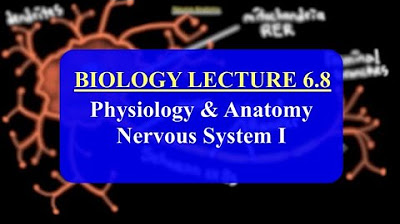IMAT Biology Lesson 6.12 | Anatomy and Physiology | Immune System Part I
Summary
TLDRIn this educational video, Andre from Med School EU introduces the complex immune system, the body's final major organ system, highlighting its critical role in defending against infections. The video outlines the immune system's two main components: the innate and adaptive responses, with a focus on the functions of various immune cells like phagocytes, neutrophils, macrophages, and lymphocytes. It also touches on the importance of recognizing self from non-self to prevent autoimmune diseases, setting the stage for a deeper dive into the innate and adaptive immune responses in the next video.
Takeaways
- 🛡️ The immune system is the body's defense mechanism against diseases and infections, constantly functioning to protect us.
- 🔬 The immune system is complex and not fully understood, with many aspects still being studied and explored.
- 🔑 Glycoproteins on cell surfaces help the immune system differentiate between self and non-self, preventing autoimmune diseases.
- 🏥 The immune system is divided into two parts: the innate immune system, which responds immediately to infections, and the adaptive immune system, which provides a stronger and more specific response later on.
- 🚑 Innate immunity acts as the first responders in the immune response, similar to CPR or first aid, while adaptive immunity is like the hospital care that follows.
- 🌱 Hematopoietic stem cells are the starting point for the development of all immune system cells, splitting into lymphoid and myeloid cells.
- 👨🔬 Myeloid cells produce various types of cells including neutrophils, eosinophils, monocytes, mast cells, basophils, dendritic cells, and macrophages.
- 🦠 Phagocytes, such as neutrophils and macrophages, engulf and destroy pathogens through a process called phagocytosis.
- 🚨 Histamine released by infected cells signals the immune system of trouble, attracting neutrophils to the site of infection through chemotaxis.
- 🔄 Lymphocytes, including B cells and T cells, are part of the adaptive immune response and are produced in the bone marrow, with T cells maturing in the thymus.
- 🧬 The diversity of B and T cells allows them to bind to specific antigens, even those from pathogens never encountered before, showcasing the adaptability of the immune system.
Q & A
What is the primary function of the immune system?
-The primary function of the immune system is to protect the body from diseases and infections, keeping us alive by constantly functioning and being alert.
What are the two main components of the immune system?
-The two main components of the immune system are the innate immune system and the adaptive immune system.
How does the immune system distinguish between self and non-self?
-The immune system distinguishes between self and non-self using glycoproteins on the surface of cells. Healthy cells have specific glycoproteins that signal to the immune cells that they are part of the body and not to be attacked.
What is the role of the innate immune system in the body's response to infection?
-The innate immune system responds immediately to an infection, acting as the first line of defense by initiating the fighting process against pathogens.
What is the adaptive immune system's response compared to the innate immune system?
-The adaptive immune system provides a stronger response that occurs later on if needed. It is activated by the innate immune system and creates memory cells to recognize and respond to attacks more effectively if they occur again.
What are the two main types of cells in the immune system?
-The two main types of cells in the immune system are lymphoid cells and myeloid cells.
What is the main function of phagocytes in the immune system?
-Phagocytes are cells that perform phagocytosis, which means they engulf and dissolve pathogens and dead cells, playing a crucial role in the body's defense against infections.
What is the difference between neutrophils and macrophages in terms of their role in the immune response?
-Neutrophils are short-lived cells that rapidly attack pathogens, while macrophages have a longer lifespan and play a role in initiating the adaptive immune response by displaying antigens from pathogens on their surface.
How do B cells and T cells differ in their development and maturation process?
-B cells mature in the bone marrow, while T cells migrate from the bone marrow to the thymus where they mature. The thymus also educates T cells to recognize self and non-self, eliminating most T cells that do not pass this test.
What is the significance of the thymus in the development of T cells?
-The thymus is where T cells mature and are educated to distinguish between self and non-self. It is also known as a 'deadly university' because it eliminates a large number of T cells during this process.
What is the process of phagocytosis and how does it relate to the immune response?
-Phagocytosis is the process by which phagocytes engulf and digest pathogens. It begins with the attraction of neutrophils to the site of infection by histamine released by infected cells, leading to the engulfment and destruction of pathogens.
Outlines

This section is available to paid users only. Please upgrade to access this part.
Upgrade NowMindmap

This section is available to paid users only. Please upgrade to access this part.
Upgrade NowKeywords

This section is available to paid users only. Please upgrade to access this part.
Upgrade NowHighlights

This section is available to paid users only. Please upgrade to access this part.
Upgrade NowTranscripts

This section is available to paid users only. Please upgrade to access this part.
Upgrade NowBrowse More Related Video
5.0 / 5 (0 votes)





